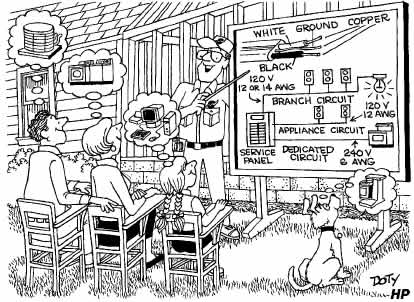May 2001
House Wiring 101
Whether you're building a new home, remodeling an old one, or just doing some electrical upgrades, at some point you'll probably need to discuss installation questions with your electrician. Although you're not supposed to be the expert, it pays to know at least the basics of a home wiring system and its principal components.
 Residential circuits are defined by the National Electrical Code, which also specifies the minimum number and kinds of circuits a home will need, their installation requirements, and similar specifications for the receptacles, lights and other devices powered by the circuits. Keep in mind that it's acceptable - and often advisable - to go beyond the Code's minimum requirements.
Residential circuits are defined by the National Electrical Code, which also specifies the minimum number and kinds of circuits a home will need, their installation requirements, and similar specifications for the receptacles, lights and other devices powered by the circuits. Keep in mind that it's acceptable - and often advisable - to go beyond the Code's minimum requirements.
There are many types of circuits, but all circuits create an unbroken path along which electrical current flows. The name "circuit" comes from the fact that electricity travels a circular route, from the power source to the device or outlet and back again.
Most modern home wiring circuits consist of a single, vinyl-jacketed electrical cable containing two or more insulated solid-copper wires plus a bare copper grounding wire. One of these wires, the so-called "hot" leg, is usually covered in black insulation and carries the electricity from the main service panel to the outlets or fixtures. If there is a second or third hot leg in the cable, its insulation is often red or blue. The "neutral" wire is covered in white insulation, and it returns the electricity back to the panel. The grounding wire (bare or covered in green insulation) is there to protect you from shock by diverting any stray current directly to earth, such as in the event of a short circuit or other fault.
A circuit may be classified by how much voltage or current it can safely handle, by what type of cable it uses, or by what is connected to it. Residential circuits in the USA carry 120 or 240 volts. General-use "branch" circuits deliver electricity to a home's wall receptacles, switches and installed fixtures such as ceiling lights. Most are 120-volt circuits wired with 12- or 14-AWG copper, and they are each protected from overload by a 15-amp fuse or circuit breaker located at the service panel.
Small-appliance circuits sometimes power higher-amperage household gadgets like toasters and hair dryers. They are also rated at 120 volts, but have higher-capacity 20-amp breakers or fuses and 12-AWG wiring. These circuits are usually installed in kitchens, bathrooms and laundry areas.
A dedicated circuit is an unbroken, unshared wiring run to an individual appliance or piece of equipment. Ranges, clothes dryers, water heaters, furnaces and central air-conditioners typically require dedicated circuits. Their voltage depends on the type of equipment they supply. Appliances with high electrical demands usually require 240-volt circuits, with a cable that includes two hot wires, one neutral, and one ground. These wires are typically larger: 10-, 8- and 6-AW G (lower AWG, or gage, numbers indicate larger wires).
If you live in an older home, or in any home with inadequate wiring, you may have an insufficient number of circuits for your needs. If circuit breakers trip or fuses frequently blow, your system could be overloaded and unable to keep up with the demand. Consult a qualified electrician if you experience these warning signs.
